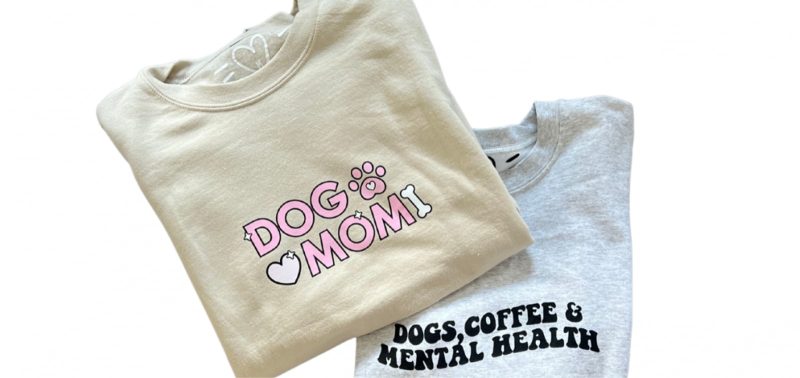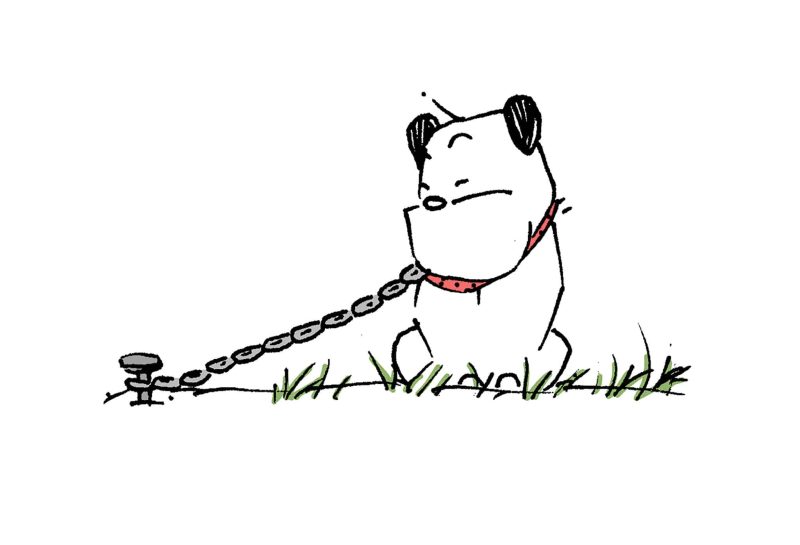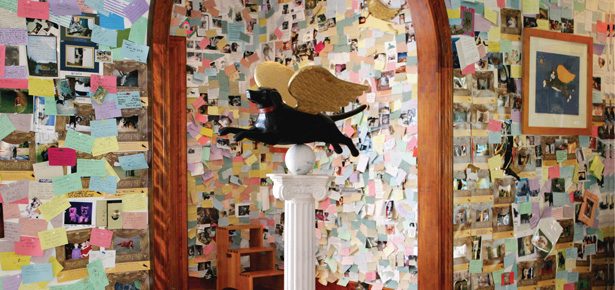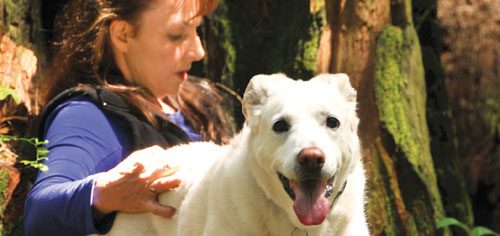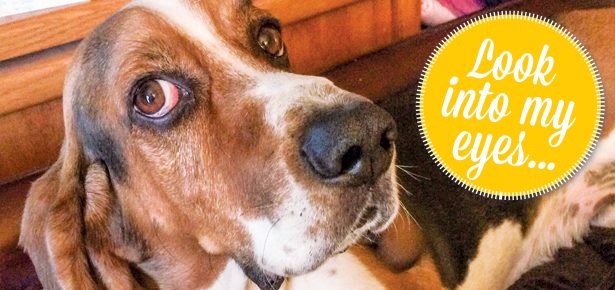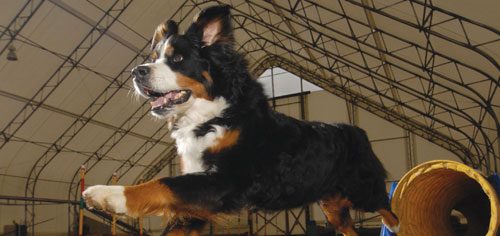
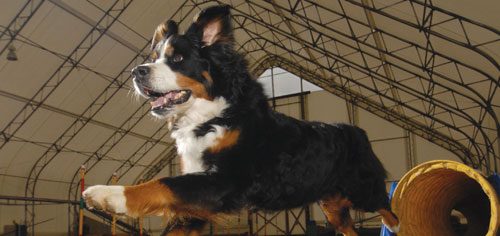
Running Naked: Agility in Action
Brio is currently one of Canada's top dogs in agility, a wildly popular canine sport that requires dogs to run a course of jumps, ramps, tunnels, and other special obstacles like the weave poles and the teetertotter. The United States Dog Agility Association, just one of several bodies that organize agility events, represents more than 100 affiliated groups and reports more than 20,000 registered competitors throughout North America, Puerto Rico, Guatemala, Costa Rica, Bermuda, and places as far-flung as Spain and Japan. Agility competitors are timed and those with the least "faults" such as knockdowns or other errors, combined with the fastest time win "legs" toward agility titles as well as placement ribbons in their class.
"READY!" Brio, a quivering snow ball of energy, balances on hind legs, front paws pushing up and down, praying, begging to be released. His eyes are fixed on owner Sherrie Shorman. "Set!" The Bichon flips around. "Go! Jump!"
At last! Brio flies over the first hurdle with Shorman running to his left. "Tunnel!" He turns a sharp left, disappearing inside what looks like a giant vacuum hose laid on the ground. Shorman meets him at the opposite end with praise‹ "Yes!"‹and points to the next obstacle: "Dance!" Without missing a beat, the Bichon kicks up ruddy earth as he races to a set of poles planted upright in the ground in a line. Side by side, dog and owner take on the challenge. Brio weaves rapidly in and out through the poles while Shorman does a highstepping, tip-toed tap dance alongside, rolling her tongue in a long-winded RRRRRRRRR that urges Brio through the weaves and across the finish line. "Good boy!" Shorman rewards Brio with treats and tosses his favourite ball.
Brio is currently one of Canada’s top dogs in agility, a wildly popular canine sport that requires dogs to run a course of jumps, ramps, tunnels, and other special obstacles like the weave poles and the teetertotter. The United States Dog Agility Association, just one of several bodies that organize agility events, represents more than 100 affiliated groups and reports more than 20,000 registered competitors throughout North America, Puerto Rico, Guatemala, Costa Rica, Bermuda, and places as far-flung as Spain and Japan. Agility competitors are timed and those with the least "faults" such as knockdowns or other errors, combined with the fastest time win "legs" toward agility titles as well as placement ribbons in their class.
Handlers run with the dogs on the course to guide and encourage them, but they may not touch the dogs or the obstacles during a competitive run. The sport demands physical agility, speed, and skill, but, most of all, teamwork. To succeed, a dog must be fast and keen, but must also accept direction from his human partner. Dogs must work without collars (a rule based on safety considerations), leading to many jokes about "naked" dogs, but this perfectly symbolizes the need for partnership: a collarless dog is a dog well beyond the power of a handler to physically intimidate. If your dog can’t run naked and work with voice direction alone, you aren’t ready for agility competition. At Highrun Dog Sport Facility in Pitt Meadows, British Columbia, owner/ trainer Bev Mattson brings communication between dogs and their owners to a new level. Starting with the Nanaimo Kennel Club on Vancouver Island in 1997, Mattson soon knew she’d found her niche in agility. She attended seminars and training sessions and ultimately began trialing (competing). In a covered barn with no side walls, she trained others. After a move to the mainland, she sensed there was a need for more competition and training opportunities in the area. Although she first conducted classes outside and in horse arenas, she knew she wanted a purpose-built facility to house the training sessions. "I needed a roof over my head and a facility just for dogs so I wouldn’t have to clean up horse manure anymore," she explains. She built it and teams of dogs and their owners came to run. "We’ve forgotten to run with our dogs," she says. "Run! That’s what agility is."
On this particular evening, Mattson is working with master-level teams of dogs and owners. Tracey Mallinson, 40, horticulturalist/ dance teacher, brings Acer, a Poodle sporting decorated French-braided hair. Acer skims through the tire hoop. Speed is his middle name as he dives after his toy squirrel thrown at the finish line. Laurie Huston, 31, professional painter, and Fletcher, her Lab cross, move to the starting line. Fletcher circles Huston then waits under her legs. "This way I can line him up with where he’s going to go," Huston explains. Marian McCormack, 43, food industry, gives commands from 5 metres away to Jessie, her Border Collie/ Blue Heeler cross.
For beginners, a six-week session costs $70. The requirements are minimal: dogand people-friendly, current vaccinations, and basic obedience skills. Beginning level is started on-leash. Eventually dogs run off-leash. Highrun houses a dog playground equipped with teeter-totters, tunnels, hurdles, dog-walk planks, pause table, weave poles, A-frame, and tire hoops. Here dogs climb, jump, stretch, and crawl over, under, around and through obstacles with their handlers guiding them in a race against time.
At the beginner level, Mattson combines obedience with foundation agility. Obstacles like planks and jumps are at ground level, tunnels are short and straight, and the A-frame is flattened out. Sessions include valuable and fun exercises such as turning your dog into, away from, and around your body.
"In my experience 90 percent of the dogs take to it right away," Mattson says. She shares a story about the first class Flora, her Bernese Mountain Dog, attended. "The A-frame was the first obstacle. Flora climbed over and back, then over and back again. And again. Ears flying. Huge smile on her face. Woohoo-Woohoo! She just kept doing it. Seven times. I had no control. I was so embarrassed. My trainer told me to leave her as she wasn’t being unsafe. Flora was having so much fun she couldn’t contain herself. I learned a valuable thing: never come down on your dog. It’s about fun."
The team of Mattson and Flora went on to win a first place at the very first Canadian National Agility Competition in 2001.
Embarrassing first-class moments can chase even the most courageous of the pack straight to their den to lick emotional wounds, but they usually return. "You get addicted." Shorman says. "When I’m three blocks away, my dogs start crying, excited to be going. Brio wags his tail, shakes, and barks. Agility is great exercise. My relationship with Brio is so close because of agility. It creates a tight bond, more communication, more love." Mattson echoes this sentiment with the story of Atsak, an American Eskimo Dog who had lost his sight. "Agility gave him confidence, got him through his later years. He’d go into our barn, do the old teeter over and over then the tunnels back and forth [even though] he was totally blind." As Mattson succinctly puts it, "Fun and the relationship between you and [your dog] are most important. It’s about little things, the look on her face when she comes off the teeter, the silly things the two of you do on the course. It’s about having fun with your dog. That’s what’s important."
Join the newsletter and never miss out on dog content again!
"*" indicates required fields
By clicking the arrow, you agree to our web Terms of Use and Privacy & Cookie Policy. Easy unsubscribe links are provided in every email.
